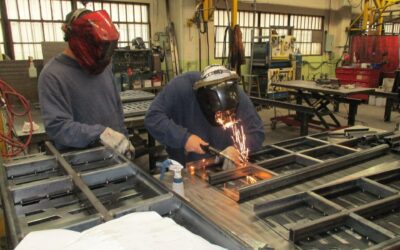As part of my process intensification work for Manufacturing USA’s RAPID Institute, I came across “Small Modular Infrastructure” by Dahlgren et al. (The Engineering Economist) that highlights the shift in project analysis that makes small modular manufacturing the heir apparent for chemical manufacturing. This post summarizes the 5 key advantages of modular manufacturing noted in this article.
First a bit of background, RAPID is focused on manufacturing modules (e.g. drop in shipping container sized components) with process intensification principles. At its core, RAPID believes that with the advent of better process controls, advances in material science, and rationalized risk project costing, modular manufacturing will prevail and greatly reduce the energy inputs for chemical manufacturing.
Conventional cost engineering holds that capital costs per unit of capacity decline with increasing size. This time-honored view is based on well-established dogma.
- Labor costs are often fixed and do not scale with volume (one driver for one 100-ton dump truck is more efficient than 10 drivers of 10 ton trucks.)
- Volume increases non-linearly to cost (think surface area vs. volume). Plus, volume may not increase footprint costs (e.g. build height).
There are numerous examples of complex processes replaced by smaller, less capable machines. Most notable is the switch from powerful mainframes to distributed PCs. In addition, it is interesting that the capital costs to produce power in automobiles ($10/kW) is 2 orders of magnitude lower than in power plants ($1000/kW). Furthermore, the labor issue can often be moot as advanced automation controls can reduce labor to remarkably low levels, completely removing the cost savings advantage of large plants.
So this suggests that modular manufacturing is not as expensive as originally thought, opening up the possibility of considering it as a design option and the ability to recognize other savings heretofore not possible.
5 forms of savings that come with decreased risk or increased flexibility
1) Market Flexibility. A 1000 ton/day plant is locked into providing this amount of product or suffer large inefficiencies (through warehousing or inefficient manufacture). A plant built on many small modules instead has the benefit of effortlessly scaling down to meet demand and making continuous maintenance simple. This model would also allow straight-forward peak pricing possibilities.
2) Location Flexibility. With modular construction, plants can be placed in the most cost-effective locations. If space is limited at existing sites, or large lots are not available, modular allows a smaller plant to be placed at the point of need for additional savings. Also, modular deployment also means easy redeployment or repositioning, while stick built plants are immovable.
3) Investment flexibility. Acknowledging that sizing a plant for the future has only an 80% accuracy rate for any given year, and noting that it may take 10 years to get from bench to deployment, the author calculates that a 5-module deployment, will have 30-35% capital equipment savings over a single large plant without considering lead time advantages. If a 30% shorter lead-time is also factored in, the savings grow to over 40%.
4) Uptime/Output. A modularized plant can guarantee output at less expense because less overall capacity is required (e.g. to guarantee 100 units with one module at 90% uptime, 300 units of extra capacity is needed. With 10 modules, the extra capacity drops to just 50.) Using modules requires less capital investment or less inventory requirements.
5) Safety. Modular components could be picked up and serviced at the factory, standardizing maintenance and reducing the need for field personnel. Reduction in size also allows for the relaxing of safety constraints, as a single failure is easier to contain. Also by manufacturing of hazardous chemicals at the point of need, transportation cost and risk are greatly reduced.
RAPID plans to activate these inherent savings by establishing a supply chain to achieve economies of scale. This process will also enhance the development of module components using process intensification principles to make smaller, less expensive modules.
Learn more about RAPID Here
OMEP and the other 50 Manufacturing Extension Partnerships are contracted as small business engagement managers to help your company determine if any of the 14 Manufacturing USA Institutes can offer your firm a competitive advantage.



